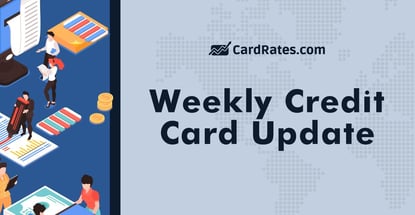For media inquiries on these stories and more, contact credit card expert and industry analyst Bill Hardekopf at (205) 985-9725 or billh@cardrates.com.
1. JPMorgan, Others Plan to Issue Credit Cards to People With No Credit Scores
 Some of the largest U.S. banks plan to start sharing data on customers’ deposit accounts as part of a government-backed initiative to extend credit to people who have traditionally lacked opportunities to borrow.
Some of the largest U.S. banks plan to start sharing data on customers’ deposit accounts as part of a government-backed initiative to extend credit to people who have traditionally lacked opportunities to borrow.
JPMorgan Chase, Wells Fargo, U.S. Bancorp and others will factor in information from applicants’ checking or savings accounts at other financial institutions to increase their chances of being approved for credit cards. It is aimed at individuals who don’t have credit scores but who are financially responsible. The banks would consider applicants’ account balances over time and their overdraft histories.
The effort, if successful, would mark a significant change in the underwriting tactics of big banks, which for decades have enshrined credit scores and credit reports as the main tools to determine who gets a loan.
• Story By: Peter Rudegeair and AnnaMaria Andriotis, The Wall Street Journal
2. U.S. Households Borrow More Than Ever, Just Not on Credit Cards
 Americans increased their borrowing to a record of $14.6 trillion in March, driven by home and auto loans. But the growth masked what Federal Reserve Bank of New York researchers called a “confounding” decline in credit card balances during a quarter when retail sales soared and travel resumed.
Americans increased their borrowing to a record of $14.6 trillion in March, driven by home and auto loans. But the growth masked what Federal Reserve Bank of New York researchers called a “confounding” decline in credit card balances during a quarter when retail sales soared and travel resumed.
Credit card balances shrank by $49 billion in the first quarter, the second-largest quarterly decline since the data started being compiled in 1999. The largest was in the second quarter of 2020, when business activity was frozen by lockdowns. An influx of pandemic relief cash from the government and payment moratoriums on student loans and other bills has enabled people to pay down their credit card balances for months now.
Credit card balances are now $157 billion lower than they were at the end of 2019, before the COVID-19 health crisis hit.
• Story By: Alexandre Tanzi, Bloomberg
3. College Students are Spending More on Credit Cards
 Nearly a third of college students say their families have been financially impacted by the COVID-19 pandemic, according to a recent survey. As a result, 19% expect to take on more debt. Some of that debt, it seems, will be on credit cards.
Nearly a third of college students say their families have been financially impacted by the COVID-19 pandemic, according to a recent survey. As a result, 19% expect to take on more debt. Some of that debt, it seems, will be on credit cards.
Half of college students, 53%, are charging purchases to two or more credit cards. That’s up from 41% last year and nearly double the 25% who reported using multiple credit cards in 2012. Many students will likely carry balances on these cards: 38% do not plan to pay off their bill each month. About 40% say they currently have at least $1,000 in credit card debt and 14% report having more than $5,000.
• Story By: Megan Leonhardt, CNBC
4. Credit Card Debt Keeps Falling. Banks Are on Edge.
 Americans are paying down their credit card debt at levels not seen in years. That is good news for everyone but credit card issuers. Large card issuers that cater to borrowers ranging from the affluent to the subprime say that overall card balances — and thus the firms’ interest income — are falling.
Americans are paying down their credit card debt at levels not seen in years. That is good news for everyone but credit card issuers. Large card issuers that cater to borrowers ranging from the affluent to the subprime say that overall card balances — and thus the firms’ interest income — are falling.
To make up for it, issuers are spending more on marketing and loosening their underwriting standards. Discover said the share of card balances that were paid off at the end of the first quarter was at the highest level since 2000. Capital One said that nearly half of the credit card balances it had at the beginning of March were paid off by the end of the month, which the company described as historically high. Synchrony Financial, the largest issuer of store credit cards in the U.S., said payment rates have been higher than they averaged before the pandemic.
Card balances at the three companies were down 9%, 17% and 7% in the first quarter from a year prior, respectively.
• Story By: AnnaMaria Andriotis, The Wall Street Journal
5. Rising Gasoline Prices: Bad For Consumers, Good For Credit Cards
 Gasoline prices in the United States, for regular gasoline, increased from an average of $2.015 per gallon in November 2020, to the current level of $2.771, according to the US Energy Information Administration.
Gasoline prices in the United States, for regular gasoline, increased from an average of $2.015 per gallon in November 2020, to the current level of $2.771, according to the US Energy Information Administration.
Now, with the Colonial Pipeline cyberattack, the average cost of gas is expected to push past $3.00 per gallon, the highest rate since 2014. With increasing prices and looming inflation, credit card issuers will see increased card spend, 40% or so, which will bleed over into revolving debt. Consumers who reduced their commutation expense as they shuttered at home now face price increases as they return.
• Story By: Brian Riley, Payments Journal
6. A Fed Report on Debit Costs Could Fuel a Movement to Reduce a Decade-Old Fee Cap
 Pressure may be building on the Federal Reserve to take action on a debit card interchange fee regulation that it has left intact for 10 years despite sweeping changes in the payments business, including an onrush of e-commerce transactions over the past year.
Pressure may be building on the Federal Reserve to take action on a debit card interchange fee regulation that it has left intact for 10 years despite sweeping changes in the payments business, including an onrush of e-commerce transactions over the past year.
In part, observers are reacting to a report the Fed released Friday indicating that issuers’ authorization, clearing, and settlement costs for debit have declined dramatically over the years. In 2019, those costs came to 3.9 cents per transaction, roughly half the costs in 2009, according to the report. At the same time, the 10-year-old Fed ceiling on debit card interchange, which flows to issuers, in 2019 was greater than total ACS costs plus fraud losses for nearly 79% of covered issuers and close to 100% of covered transactions.
• Story By: John Stewart, Digital Transactions
7. Debt Collectors Spending Big to Block a Crackdown
 Two months ago, debt collectors won a victory when congressional lawmakers allowed stimulus checks to be garnished by creditors and government agencies. Now, as the credit industry hits a jackpot during the pandemic, the leading lobby group for debt collectors has more than tripled the amount of cash it funnels to lawmakers as it campaigns to block upcoming Democratic legislation to protect millions of Americans from the repo man.
Two months ago, debt collectors won a victory when congressional lawmakers allowed stimulus checks to be garnished by creditors and government agencies. Now, as the credit industry hits a jackpot during the pandemic, the leading lobby group for debt collectors has more than tripled the amount of cash it funnels to lawmakers as it campaigns to block upcoming Democratic legislation to protect millions of Americans from the repo man.
At issue is a package of bills designed to restrict the $13 billion debt collection industry, as new Federal Reserve and Census Bureau reports show consumer and medical debt has skyrocketed during the pandemic.
• Story By: David Sirota, Daily Beast
8. Cardholders Can Earn Up to $200 Back at Amazon, Plus Up to $150 Cash Back With the Amex Blue Cash Cards
 American Express announced that it is offering new Blue Cash cardholders updated cash back bonuses on their Amazon.com spending. Cards eligible for earning 20% back on Amazon.com purchases within the first six months of card membership include the Blue Cash Preferred Card (up to $200 back) and the Blue Cash Everyday Card (up to $150 back).
American Express announced that it is offering new Blue Cash cardholders updated cash back bonuses on their Amazon.com spending. Cards eligible for earning 20% back on Amazon.com purchases within the first six months of card membership include the Blue Cash Preferred Card (up to $200 back) and the Blue Cash Everyday Card (up to $150 back).
Each card also comes with an additional cash back bonus after you reach certain spending requirements, so new cardholders can earn up to $350 in total with these welcome offers.
• Story By: Elizabeth Gravier, CNBC
9. Chase Adds DoorDash Perks to Most Co-Branded Credit Cards
 Previously, Chase offered a complimentary DashPass membership to Chase Sapphire Reserve and Chase Sapphire Preferred cardholders for a minimum of one year, plus up to $120 in credits that Sapphire Reserve cardholders could use to cover some of their orders.
Previously, Chase offered a complimentary DashPass membership to Chase Sapphire Reserve and Chase Sapphire Preferred cardholders for a minimum of one year, plus up to $120 in credits that Sapphire Reserve cardholders could use to cover some of their orders.
Chase Freedom, Freedom Flex, Freedom Unlimited, and Slate cardholders could get a complimentary DashPass membership for three months, then a 50% discount on the membership for the following nine months. Now, Chase is extending DoorDash benefits to most of its co-branded cards. Eligible cardholders will get 5% in DoorDash credit on pickup orders and a one-year complimentary DashPass membership, which offers free delivery and reduced service fees on orders of $12 or more with participating restaurants, convenience stores, and grocery stores.
• Story By: Ben Luthi, Investopedia
10. The Numbers Behind Younger Users’ Love Affair With Mobile Wallets and Online Banking
 While mobile-wallet ownership holds steady at 45%, younger consumers are embracing the payment technology more readily than they were 10 months ago, according to research from the big processor FIS. At the same time, though, mobile-wallet ownership has decreased among senior Millennials, Gen Xers, and Baby Boomers.
While mobile-wallet ownership holds steady at 45%, younger consumers are embracing the payment technology more readily than they were 10 months ago, according to research from the big processor FIS. At the same time, though, mobile-wallet ownership has decreased among senior Millennials, Gen Xers, and Baby Boomers.
As of February, 65% of young Millennials use a mobile wallet, compared to 59% in April 2020. In addition, 57% of Gen Zer’s use mobile wallets, up from 50% in 2020. When it comes to using mobile/online banking, young Millennials continue to favor the online channel, with 29% saying they use mobile/online banking to conduct transactions they normally would in a branch.
• Story By: Peter Lucas, Digital Transactions
11. Here’s How Much Your Personal Information is Worth to Cybercriminals — and What They Do with It
 Data breaches have become common, and billions of records are stolen worldwide every year. Most of the media coverage of data breaches tends to focus on how the breach happened, how many records were stolen, and the financial and legal impact of the incident for organizations and individuals affected by the breach.
Data breaches have become common, and billions of records are stolen worldwide every year. Most of the media coverage of data breaches tends to focus on how the breach happened, how many records were stolen, and the financial and legal impact of the incident for organizations and individuals affected by the breach.
But what happens to the data that is stolen during these incidents?
• Story By: Ravi Sen, The Conversation
Advertiser Disclosure
CardRates.com is a free online resource that offers valuable content and comparison services to users. To keep this resource 100% free, we receive compensation for referrals for many of the offers listed on the site. Along with key review factors, this compensation may impact how and where products appear across CardRates.com (including, for example, the order in which they appear). CardRates.com does not include the entire universe of available offers. Editorial opinions expressed on the site are strictly our own and are not provided, endorsed, or approved by advertisers.





![Game Over: Here’s Why the Best Credit Card Rewards May End Soon ([updated_month_year]) Game Over: Here’s Why the Best Credit Card Rewards May End Soon ([updated_month_year])](https://www.cardrates.com/images/uploads/2019/01/game-over-credit-card-rewards.jpg?width=158&height=120&fit=crop)


![3 FAQs: ATM Card vs. Debit Card vs. Credit Card ([updated_month_year]) 3 FAQs: ATM Card vs. Debit Card vs. Credit Card ([updated_month_year])](https://www.cardrates.com/images/uploads/2016/05/atm-card-vs-debit-card-vs-credit-card--1.png?width=158&height=120&fit=crop)
![What Card is in the Jennifer Garner Credit Card Commercial? ([updated_month_year]) What Card is in the Jennifer Garner Credit Card Commercial? ([updated_month_year])](https://www.cardrates.com/images/uploads/2018/05/jennifer-2.jpg?width=158&height=120&fit=crop)
![Can You Pay a Credit Card with a Credit Card? 3 Ways Explained ([updated_month_year]) Can You Pay a Credit Card with a Credit Card? 3 Ways Explained ([updated_month_year])](https://www.cardrates.com/images/uploads/2017/02/card-with-card-2.png?width=158&height=120&fit=crop)
